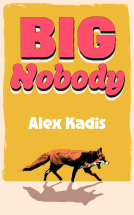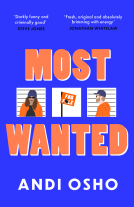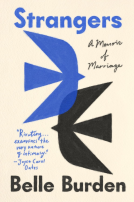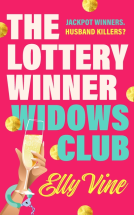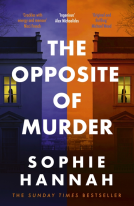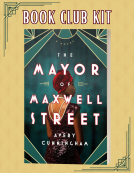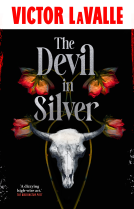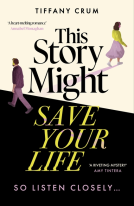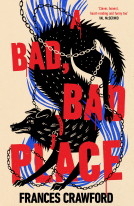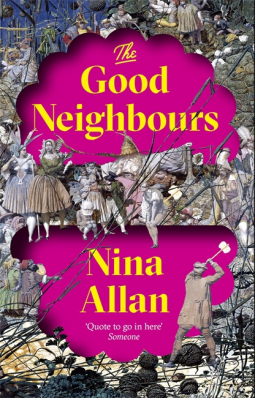
The Good Neighbours
by Nina Allan
This title was previously available on NetGalley and is now archived.
Send NetGalley books directly to your Kindle or Kindle app
1
To read on a Kindle or Kindle app, please add kindle@netgalley.com as an approved email address to receive files in your Amazon account. Click here for step-by-step instructions.
2
Also find your Kindle email address within your Amazon account, and enter it here.
Pub Date 10 Jun 2021 | Archive Date 3 Aug 2021
Quercus Books | riverrun
Talking about this book? Use #TheGoodNeighbours #NetGalley. More hashtag tips!
Description
Cath is a photographer hoping to go freelance, working in a record shop to pay the rent and eking out her time with her manager Steve. He thinks her photography is detective work, drawing attention to things that would otherwise pass unseen and maybe he's right . . .
Starting work on her new project - photographing murder houses - she returns to the island where she grew up for the first time since she left for Glasgow when she was just eighteen. The Isle of Bute is embedded in her identity, the draughty house that overlooked the bay, the feeling of being nowhere, the memory of her childhood friend Shirley Craigie and the devastating murder of her family by the father, John Craigie.
Arriving at the Craigie house, Cath finds that it's occupied by Financial Analyst Alice Rahman. Her bid to escape the city lifestyle, the anxiety she felt in that world, led her to leave London and settle on the island. The strangeness of the situation brings them closer, leading them to reinvestigate the Craigie murder. Now, within the walls of the Craigie house, Cath can uncover the nefarious truths and curious nature of John Craigie: his violent upbringing and controlling nature, his hidden obsession with the work of Richard Dadd and the local myths of the fairy folk and his apparently cowed wife Susan.
Nina Allan, the critically acclaimed author of The Dollmaker, skilfully weaves a haunting domestic noir about memory, obsession and trauma. It will delight both crime fans and lovers of literary fiction.
Available Editions
| EDITION | Other Format |
| ISBN | 9781529405170 |
| PRICE | £16.99 (GBP) |
| PAGES | 304 |
Average rating from 34 members
Featured Reviews
Nina Allan's books are among my favourite reads of recent years so I was VERY excited to that The Good Neighbours was coming - and indeed, it's classic Allan, an apparently simply story but which proves to have many depths and currents to it.
We first meet Cath, whose story this (mainly) is, getting ready, with her friend Shirley Craigie, for a Saturday trip to the Big Town. Shirley's doing her makeup, Cath, less daring, just her nails. There's a warm teenage friendship between the two young women which comes over strongly in this first scene and to which Allan returns again and again. The detail is goods: as the two leave they hear Shirley's mum Susan singing 'like Lizzie Dreams on Playdays' and this moves on to a memory of her (jealous, overprotective?) dad, John.
Cath and Shirley live on an island, not hopelessly remote but a ferry ride away from the mainland, and then a bus trip into town, which as it happens is Glasgow. That gives the day a bit of a frisson - if you miss the ferry, you're stranded - as does the girls' sneaking into a bar for vodka and Shirley's nicking a camisole from a shop. Looming behind that, though, is John's attitude of control and general disapproval. (Cath's parents don't like her spending time at Shirley's house).
Fast forward a few years and Cath is working in a Glasgow record shop and trying to establish herself as a photographer. She's in a dead-end affair with a married man, and Shirley is nowhere on the scene. Cath is working on a photograph project to document "murder houses" - places where killings have taken place. We see her examine a house in Glasgow, delving into the case - the victim and her background, and the presumed murderer. Then she decides to return to the island - where the house she's interested in is that one we saw at start of the book, Shirley's, house, where she, her mother, and her little brother were murdered by John Craigie.
I loved the way that, in this story, Allan shows us Cath essentially being stuck. What happened back on the island derailed her life, turning her from a straightford path - school high flier, good university, good job - to... something else. The delicacy of the way Allan does this is impossible to explain without oversimplifying. It's not "my childhood friend was murdered and I never came to terms with that" (though that is true). It's more about understanding, knowing, seeing. Part of that is learning what actually happened to Shirley and her family - there is an official account but it doesn't satisfy Cath - but part is also about appreciating her, Caths's, own place in everything. Was what happened, at some level, her fault? Cath decides to find out - not only by viewing the house where everything happened (now owned by Alice, a financial analyst seeking refuge from London) but also by looking into the background (which proves surprisingly shifty).
That makes the story sound like a crime novel and if you want to see it that way, it is a fine crime novel. But there is much more to it. Allan's novels often come with hidden wiring - they may allude to nested fictional worlds either overtly (such as through stories-within-stories) or implicitly through themes of craft or artistic accomplishment, skills which create their own worlds or make gateways to others. The Good Neighbours is apparently more straightforward but it still has at its centre a whiff of strangeness.
There is a man - Craigie - who cannot read, but seems to have had a rare talent for working in wood ('wood was warmer than stone and wood was kind') and who has encoded his life in some sense in a doll's house (but the dolls themselves are missing). Similarly, Alice has formidable talent for maths - her breakdown is connected with her (mis?)using this in finance. Dovetailing with that are speculations about "many worlds" quantum mechanics and its possible links to fairy, supported by the parallel careers of (real) Victorian painter Richard Dadd and (fictitious) linguist and mathematician Mabel Konig, both of who returned from trips to the Near East with changed perspectives on art, nature and reality.
All of this creates a sense of something strange which remains tantalisingly close, yet impossible to grasp. So, again, you could focus on those aspects of the novel and see it as fantasy/ SF. But while that background, and the theme of the "Good Neighbours" themselves, in folklore, in Craigie's early life and in Alice's family stories, are always present here, like a river flowing nearby - stop and listen for a moment and you can hear it running - they are not "all" the story. In reality I think this book is a wonderful dance of all those themes, and more, for example Craigie's violence and controlling behaviour (both their origins and the failure of an apparently close-knit community - in fact, more than one - to confront that). This in turn has echoes I think in Alice's relationship with her partner, something we only see in glimpses.
There are some secrets here, which emerge in their own good time, so, yes, in some sense what actually happened is clear by the time the book closes, but the joy of this chewy, intricately textured novel is the journey to that point, rather than any satisfaction at having a mystery solved. It is a book to be read slowly and savoured and indeed, re-read. I would strongly recommend and I think (while it is still early days!) this will be one of my favourites of 2021.
 Reviewer 41812
Reviewer 41812
The Good Neighbours centres on Cath, who works in a record shop while pursuing her real passion, photography, on the side. When she was a teenager, her family spent a few years living on the Isle of Bute, and during that time something happened that marked her for life: the murder of her best friend Shirley by Shirley’s father, John Craigie. He also killed his wife and and Shirley’s brother Sonny, shortly before dying himself in a car crash – an act commonly believed to be suicide. When Cath returns to the island, she strikes up an uneasily intimate friendship with the woman who now lives in the Craigies’ former home. She also becomes increasingly certain he was not, in fact, the killer, and while trying to investigate the case she uncovers an incongruous fact: John Craigie believed in fairies.
Despite that, it’s arguably the least genre-inflected of Allan’s major works to date, making it a good gateway for those leery of the type of speculative literary fiction that leans heavily towards the speculative (a category that would include Allan’s first two novels). There’s a deliberate ambiguity in what Cath discovers, and what Allan shows us, about John Craigie’s beliefs. There are lots of references to the Victorian artist John Dadd, famous for his intricate paintings of fairies; his painting ‘The Fairy Feller’s Master-Stroke’ forms part of the gorgeous cover design. Dadd is also infamous for having murdered his father, whom he believed to be the devil. The paralells with Dadd tell us something about The Good Neighbours; it is, more than it might first appear, a story about the fragile and capricious nature of the human mind.
Meanwhile, parallels to John’s hold over his family emerge throughout the narrative – in Alice’s seemingly precarious relationship with her husband Saheed, and in the case of Mary Chant, whom Cath finds out about while photographing a different ‘murder house’. She is another murder victim and, like Shirley’s mother, another woman assumed to have been killed by her partner. When the truth is revealed, it’s both unexpected and depressingly predictable: a ‘twist’ that highlights the dangers of making assumptions, without undermining the facts of comparable real-life cases. When Cath thinks about Shirley, her lost friend comes to life; the character reads as a celebration of a vibrant young person rather than a morose portrait of a life cut short.
The few chapters in which another character’s perspective intrude are startling. Written loosely, colloquially, in part-dialect, they’re so good they’re thrilling, the kind of writing that makes the imagination run away with itself. And they illuminate this character in exactly the right way, without losing their essential enigma, that sense of an unsolvable conundrum that is the heart of this story.
I read The Good Neighbours very quickly, gulping it down as though I’d been deprived of good fiction for months (which isn’t true at all, I’ve read plenty of great books this year so far, but I have been starved of new work from Allan). I’ve been cursing the miserable weather lately, yet I was glad of a gloomy day on which to curl up with this book. I do want, and need, to read it again, though, to properly get under the skin of the story and discover the nuances I may have missed.
Readers who liked this book also liked:
Elly Vine
General Fiction (Adult), Mystery & Thrillers, Women's Fiction
We Are Bookish
Historical Fiction, Literary Fiction, Multicultural Interest
